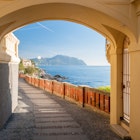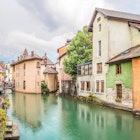
The 8 best day trips from Milan to experience the Lombardy life
Feb 25, 2021 • 8 min read

Attractions around Milan range from medieval townships to stunning vantage points overlooking Lake Como © Marco Bottigelli / Getty Images
Milan may be Italy's capital of fashion and glamor, but it's also the gateway to a whole region of rich culture, fine food and even finer scenery. Within a few hours of the city, you can splash or boat on gorgeous lakes, scramble over rugged mountain ranges, wander the laneways of medieval towns and gape in awe at Unesco-listed hill villages, ancient relics and sacred sites.
Tear yourself away from Milan's chic events, fine dining and cosmopolitan nightlife, and the rewards are many and varied. Whether it's a stroll through the medieval alleys of Bergamo or a boat trip on Lake Como, a day trips from Milan will broaden your experience of this wonderful corner of Italy, and it's a beautiful region to explore in spring, before the summer crowds arrive. Here are eight of the very best day trips from Milan.
Lake Como
Why go?: To experience la bella vita
Studded with lavish villas and backed by the dramatic scenery of the Italian Alps, languid Lake Como was a playground for the rich and famous long before George Clooney showed up on the scene. Perhaps the best way to experience the lake is by renting a boat (no boat license is required) to cruise from one charming town to the next.
Highlights include touristy but beautiful Bellagio, with its sweep of terracotta-tiled rooftops, and the pretty towns of Varenna, Menaggio and Como. Take time to admire imposing villas such as Tremezzo's Villa Carlotta and Villa Balbianiello in Lenno – you might recognize the latter from movies including Star Wars: Episode II Attack of the Clones and Casino Royale.
How to get to Lake Como: Trains leave regularly from the Cadorna, Porta Garibaldi and Centrale train stations in Milan, stopping at Como Nord Lago. The trip takes up to 90 minutes (depending on whether the train is direct or not). Alternatively, you can drive here in about an hour from central Milan via the E62 and A9 highways.
Lake Maggiore and the Borromean Islands
Why go?: For an island escape
While less celebrated than Lake Como, Lake Maggiore is no less beautiful, and it's home to the three treasured Borromean Islands. Named for the aristocratic family who acquired these lovely specks of land in the 16th and 17th centuries, the islands each have their own distinctive charm, and it's worth taking time to explore all three.
Isola Bella is famous for its luxurious baroque palace and romantic Italian-style gardens, while Isola Madre has 20 acres of landscaped botanical gardens complete with exotic plants and birds, part of the elegant Palazzo Madre. Finally, Superiore (also known as Isola dei Pescatori, thanks to its origins as a humble fishing village) was largely left to its own devices. It has 25 or so residents today, who continue to follow a simple, traditional way of life.
How to get to Lake Maggiore: Take a train from the Porta Garibaldi or Centrale stations in Milan and get off at Stresa (worth a visit in its own right), where you can arrange a boat trip to the islands. The trip to Stresa takes about 90 minutes whether you travel by train or by car. The prettiest road routes hug the lake's west bank, climbing up through the Val Cannobina and then down to Locarno.

Bergamo
Why go?: For the historic architecture
With the rugged mountain ranges of the Alps in the distance, Bergamo is blessed with stunning views, and that’s not all. Divided into upper and lower districts, the lower Città Bassa shows off Bergamo's modern face, while the upper Città Alta sprawls across the hillside and has a beguiling fairytale-like charm.
Nestled inside 3 miles (5km) of 16th-century Unesco-listed Venetian walls is a timeless world of winding medieval alleys and elegant Renaissance buildings. Wander the streets or walk along the walls and soak up the history. Devote some time to exploring the Piazza Vecchia, lined with elegant palazzi, and the baroque Basilica di Santa Maria Maggiore.
How to get to Bergamo: Trains for Bergamo leave every hour from Milan's Porta Garibaldi and Centrale stations, and take around an hour. If you're driving from Milan, take the A4 motorway and follow the Bergamo exit signs. Traffic is restricted in the Città Alta, but you can find limited parking outside the city walls.

Lake Garda
Why go?: For the lake views
Covering 370 sq km (143 sq miles), Lake Garda (Lago di Garda) is the largest of the Italian lakes, straddling the border between three Italian regions. It's visited by nearly one in ten visitors to Italy, for its views, fine food, flanking vineyards and cultural cachet. Like an Italian lunch, exploring this region is something to be savored slowly. Many drive, visiting the lake as a stop en route to Verona, but it pays to narrow down your expectations and devote a day to exploring parts of the lakeshore in depth.
The western Lombardy-facing shore of Lake Garda is the most beautiful, lined with historic towns, stately villas, mountain-backed roads and frothing flower-filled gardens. Oriented toward the Veneto, the eastern shore has a different character, with silvery olive groves lining the shoreline. On a day trip from Milan, maximize the experience by homing in on a town such as Sirmione or Desenzano del Garda for a focused taste of the larger region.
How to get to Lake Garda: Desenzano del Garda is on the Milan–Venice train line with a fast train service that takes about an hour (and it's another half hour to Verona). The drive from Milan to Lake Garda takes approximately two hours.

Verona
Why go?: For the romantic mood
Verona is best known for its Shakespeare associations, attracting a multinational gaggle of tourists to its pretty piazzas and knot of lanes. Most come in search of Romeo and Juliet associations, which the city is very happy to provide, but it's the city backstreets rather than the touristy sights that leave the longest-lasting impression of this attractive Veneto city.
Verona's heart is dominated by a mammoth, remarkably well-preserved amphitheater from the 1st century CE, plus countless churches, a couple of architecturally fascinating bridges over the Adige River, regional wine and food from the Veneto hinterland and some impressive art galleries. It's just a short hop from Lake Garda, so the two can be combined in a long (but rushed) day trip if you're not planning to linger at the sights.
How to get to Verona: It's just over an hour on the fast train from Milan, but the trip takes closer to two hours by car. The trip between Verona and Lake Garda takes about 25 minutes.

Varese
Why go?: For art without the crowds
Varese is a prosperous provincial capital with a pretty old town and some grand villas that are worthy day trip material. On a hill overlooking the town sits the glorious 18th-century Villa Panza with its impressive collection of contemporary American art. Donated in 1996 to the not-for-profit organization, the mansion holds a collection that Count Giuseppe Panza began amassing in the 1950s.
Elegant rooms decorated with Renaissance furniture provide a grand setting for modern works, many of which explore the concepts of light and color. Dan Flavin’s dazzling neon lights are just some of the works transforming this interesting space. Once you’ve had your fill, take a scenic amble through the Italian-style gardens, complete with views and scattered outdoor installations.
How to get to Varese: From Milan's Porta Garibaldi and Cadorna stations, you can take a train that stops at Varese. Continue on Bus A from Piazzale Trieste (just outside the station) to its final stop at Piazza Litta, close by Villa Panza. The whole journey takes over an hour. It's faster to drive here via the A8 motorway from Milan; just follow the signs to the parking station at Piazza Repubblica.

Pavia
Why go?: For compact grandeur
Pavia combines the youthful buzz of a university town with the historic grandeur of a medieval township, and its small size makes it easy to explore. A stop at the University of Pavia, one of the oldest universities in Europe, is pretty much mandatory – founded in 1361, the campus has hosted such illustrious students as Ugo Foscolo, Alessandro Volta and some say even Christopher Columbus.
The Romanesque Basilica di San Michele, the 14th-century castle and the main cathedral with its massive dome are also worth a peek. Just outside the city, Certosa di Pavia is one of the oldest monasteries in Italy; built in 1396, it’s an impressive sight, blending Renaissance and Gothic architecture. Some say Pavia is worth a trip just to eat La Torria degli Aquila – the sensational cooking in this medieval tower is highly creative while still rooted in tradition.
How to get to Pavia: Trains for Pavia depart from Milan's Centrale and Rogoredo stations and take around 30 minutes. The drive is longer, at around an hour.

Monza
Why go?: For the thrill of the race
For motoring enthusiasts, the Autodromo Nazionale Monza racetrack needs no introduction. Constructed in 1922, it’s best known for hosting the Formula One Italian Grand Prix almost since the race’s inception. With its long straights and fast corners, it has a reputation as the "Temple of Speed," and watching a race here is an experience not to be missed.
Non-professional drivers with deep pockets can realize the dream of cruising in a Ferrari, Lamborghini, Gran Turismo or Formula 3 car on this hallowed stretch of tarmac. Those less inclined towards adrenaline and g-forces can experience the track in a minivan or by bike.
How to get to Monza: Trains from Milan's Centrale and Porta Garibaldi stations are the best way to travel to Monza, and the trip takes around 15 minutes. From Monza station, jump on Bus Z221 towards Carate/Mariano and disembark at Vedano al Lambro, which is walking distance from the racetrack's Porta Vedano entrance.
You might also like:
The top 22 free things to do in Milan
Milan's must-see museums: a design for life
The best things to do in Milan, from divine churches to cathedrals of fashion
Explore related stories




 Tips & AdviceCapital One transfer partners: the most valuable options for 2024
Tips & AdviceCapital One transfer partners: the most valuable options for 2024Sep 4, 2024 • 14 min read



 SportsOlympics-obsessed? Start planning your trip to the 2028 LA games now
SportsOlympics-obsessed? Start planning your trip to the 2028 LA games nowAug 1, 2024 • 5 min read

